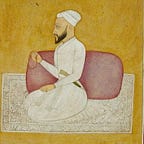I decided to take a look at the British Indian Army, and specifically, the role Punjab played during the colonial period. I’ve posted a map below highlighting the Punjab province in Colonial India, so we’re all on the same page.
Prior to 1857 the British Indian Army was comprised of three major groups; the Bengal Army in the north (United Provinces, Bihar, and Bengal), the Madras Army in the south (Tamil, Telugu, and Malayali country), and the Bombay Army in the middle (Gujarat and Maharashtra). Punjabis were only about 10% of the standing army, largely relegated to frontier forces tasked with policing the Afghan border.
This dynamic quickly changed following the 1857 Indian Rebellion. The Hindu and Muslim elites who had formed the bulk of the Bengal Army (and its defectors) were largely purged, while the Bombay and Madras Armies were significantly reduced in size. In their place the British recruited a new army. A loyal army. Consisting of tribes who had traditionally existed on the periphery of India, and would therefore have few (if any) conflicting loyalties when tasked with policing the wider region for the British.
I’m speaking of course about the Punjabis (and to a lesser extent Gurkhas, Pashtuns, and Hazaras). It was the Punjabis however, particularly the Sikh Punjabis, who served as the bulwark of this new British Indian Army. Aloof from both Hindus and Muslims, indifferent to the Mughal and Maratha empires of old, the Sikhs were the ideal soldiers for the British, and demonstrated as much during their suppression of the 1857 Rebellion.
By 1900 nearly half of British India’s soldiers were Punjabi. By 1930 the figure peaked at over 54%. When adding the additional Indian-periphery regions described above, nearly 75% of the British Indian Army was comprised of these frontier peoples (despite being only 10–15% of India’s population).
While the Punjabi share would see declines during times of expanded recruitment (particularly WW2), its clear that the reformed Indian Army was largely a Punjabi affair.
The dramatic increase of Punjabis in the British Indian Army was mirrored by a dramatic decrease in the portion of Sikh Punjabis recruited, with a corresponding increase in Muslim Punjabis. The reasons for this dynamic are threefold.
- Firstly, the British desired a primarily Punjabi army, and there simply were not enough Sikhs (only 15% of Punjab) to meet such a quota without widening recruitment.
- Secondly, many Sikhs lost interest in soldiering as they had become quite prosperous farmers, thanks in large part to the irrigation system introduced by the British in central Punjab. Conversely, the Muslim inhabitants of arid regions like Potohar had come to depend on the sustenance provided by the British Army, which would otherwise not be available to non-recruits.
- Thirdly and most crucially, the Punjabi Muslims had supplanted the Sikhs as the most trustworthy soldiers. Early 20th century Punjab was becoming a hotbed for anti-colonial activity, and the British believed sections of the Sikh community were at the center of such plots. Furthermore, the willingness of the Punjabi Muslims to fight against the Ottoman Empire during WW1 (when some Pashtuns and North Indian Muslims defected), had left the British openly impressed.
Below is the rough distribution of various Punjabi tribes in the reformed British Punjab Army. While its clear the Jats, Rajputs, and Pashtuns predominate, their does seem to be significant representation from other communities.
Regions of Punjab that saw high levels of recruitment include Rawalpindi, Jhelum, Attock, Ferozepore, Patiala, and Gurgaon. The Multan and Himachal regions saw the lowest levels of recruitment.
The primacy of Punjab in the British Indian army was codified under the “Martial Races” theory. Propagated by the British, this theory held that certain ethnic groups in India were culturally and genetically predisposed to make excellent soldiers. The agricultural-pastoral tribes of Punjab were lauded as the pinnacle of manliness and chivalry, the Muslims and Sikhs praised for their natural affinity for war.
It does not take a keen observer to note the correlation between ones loyalty to the British and their favorable portrayal as a martial race. While this ploy has largely been recognized for what it was in the modern period, echoes of the Martial Races theory persist in Pakistan and India to this day.
Notes:
All figures are approximate and can have small variations depending on different boundaries of the Punjab and methods for tabulating recruits.
Sources:
Ethnicity, Religion, Military Performance and Political Reliability — British
Recruitment Policy and The Indian Army, Major Amin
The Punjab in Peace and War, Thorburn
The Indian Army and the Making of Punjab, Mazumder
The Garrison State, Yong
Annual Returns, British India
1931 Census of the Punjab, British India
